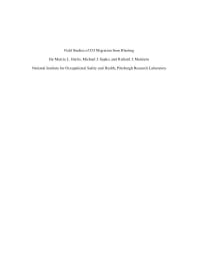Mining Publication: Field Studies of CO Migration from Blasting
Original creation date: February 2005
Authors: ML Harris, MJ Sapko, RJ Mainiero
NIOSHTIC2 Number: 20025992
Proc 31st Ann Conf Explos Blasting Tech, Orlando, FL, February 6-9, 2005, 2005; :21 pp
Since 1988, there have been 13 documented incidents in the United States and Canada in which carbon monoxide (CO) is suspected to have migrated through near-surface strata into structures or other enclosed spaces as a result of nearby trench blasting or surface mine blasting. In addition, there are 30 suspected or medically verified CO poisonings and 1 fatality associated with these incidents. To better understand the variables contributing to this hazard, the National Institute for Occupational Safety and Health (NIOSH) carried out a small-scale field study to identify key factors that may contribute to the migration of CO through the ground. NIOSH conducted single-hole, heavily confined experimental test shots to measure the radial pressure pulse as it propagated through surrounding monitoring holes to determine if a relationship existed between the pressure pulse and resulting CO measurements afterwards. NIOSH also monitored blasts at an airport construction site. Following the detonations, the concentrations of CO, nitric oxide, and nitrogen dioxide were monitored for several days in the surrounding satellite holes. The peak CO measurements relative to distances from the shots were compared. Pressure histories and peak particle velocities (PPV) were measured at monitoring boreholes. It was found that the differential pressures recorded within the boreholes give some indication as to the likelihood of CO appearing, whereas the PPV measurements do not seem to be as good an indicator for potential CO migration. In this limited study, changes in barometric pressure had very little influence on removing the trapped detonation products, whereas applying a vacuum to the monitoring holes was effective in reducing the entrapped CO concentration.

NIOSHTIC2 Number: 20025992
Proc 31st Ann Conf Explos Blasting Tech, Orlando, FL, February 6-9, 2005, 2005; :21 pp
- Blasting and Explosives
- Blasting-Related Carbon Monoxide Incident in Bristow, Virginia
- Chemical and Physical Factors that Influence N0x Production During Blasting: Exploratory Study
- CO Migration from Trench Blasting in Amherst, New York
- Dangers of Toxic Fumes from Blasting
- Factors Affecting ANFO Fumes Production
- Factors Affecting Fumes Production of an Emulsion and ANFO/Emulsion Blends
- Monitoring and Removal of CO in Blasting Operations
- A Technique for Measuring Toxic Gases Produced by Blasting Agents
- Technology News 488 - Migration of Blasting Fumes into a Western Pennsylvania Home
- Toxic Fume Comparison of a Few Explosives Used in Trench Blasting